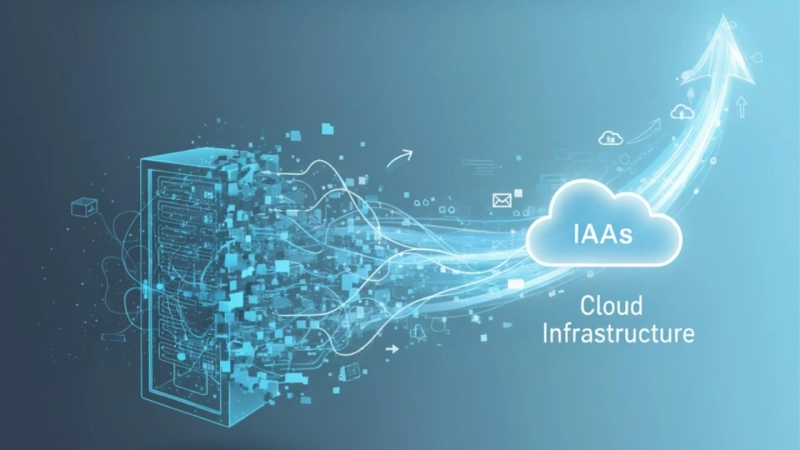I’ve seen how IaaS for IT firms is changing the way consulting businesses operate. For years, many of us relied on legacy infrastructure, but the cracks are now impossible to ignore.
Clients want faster results, simpler integrations and more cost-efficient solutions. If we stay tied to outdated systems, we risk losing relevance and business.
Why Legacy Systems Feel Like a Dead Weight
Let’s be honest, legacy infrastructure slows everything down. Legacy infrastructure to cloud migration is no longer just another buzzword. It’s the only path forward if we want to keep pace.
I’ve worked with firms where setting up a new environment took weeks. Meanwhile, clients were expecting working solutions in days. That mismatch creates frustration on both sides. Moreover, today’s projects are more complex.
Hybrid models, multi-cloud setups and data-heavy workloads need flexibility. Legacy systems were never built for that. And every year, the gap between what clients expect and what legacy systems can deliver gets wider.
Why IaaS Fits Consulting Firms So Well
This is exactly where IaaS for IT firms shines. Instead of worrying about buying or maintaining servers, we can spin up infrastructure within minutes. That speed changes everything.
The pay-as-you-go model is another game-changer. Rather than locking up money in hardware, firms can align costs directly with client projects. Moreover, scaling up or down becomes as simple as adjusting to project needs.
I’ve also seen how modern IaaS platforms improve security. Providers bake compliance and monitoring into their services, which means consulting firms can meet strict client requirements without burning extra hours. That’s more time for innovation and client success.
Clients Care About Speed More Than Ever
Here’s something I’ve learned: clients rarely ask about the infrastructure itself. What they care about is speed and outcomes. Modern infrastructure helps us deliver both.
I once worked with a mid-sized IT consultancy that moved its workloads from legacy infra to cloud. Provisioning times dropped from 12 days to just 6 hours. The firm didn’t just save time, it won repeat contracts because clients noticed the improvement.
When you deliver quickly, you build stronger relationships. Clients remember responsiveness,
and it often becomes the reason they return.
The Financial Side of IaaS
Let’s talk about cost because it’s always part of the decision. IaaS for IT firms shifts infrastructure spending from big capital purchases to flexible operating expenses. That shift alone creates breathing room.
Instead of sinking money into hardware that may sit underused, firms can invest in talent and innovation. Usage insights from IaaS also make billing more transparent, helping firms give accurate project estimates and maintain profitability.
Clients appreciate that clarity too. When infrastructure costs are predictable and included upfront, it signals trust and accountability. In consulting, those qualities matter as much as technical expertise.
Beyond Saving Costs
The real magic of legacy infra to cloud migration isn’t just lower costs, it’s the ability to innovate.
Legacy systems often force firms into maintenance mode. But with IaaS, teams can explore new technologies like AI frameworks, analytics tools or containerized environments. Suddenly, consultants can advise clients not just on keeping systems running but on moving into entirely new opportunities.
I’ve seen teams who used to spend hours fixing servers now focus on building automation pipelines or reusable frameworks. That shift redefines consulting firms from service providers into strategic partners.
Overcoming the Fear of Change
I know some firms hesitate. Migration sounds risky, with fears of downtime or retraining. But those challenges are easier to manage today.
Most providers now offer migration tools and hybrid approaches that ease the transition. A phased plan works best. Start small with less critical workloads, gain experience and then move the core systems. This way, you reduce risk while still unlocking value.
For consulting firms looking for a structured approach, following a comprehensive cloud migration strategy with clear phases like rehosting, replatforming, and refactoring can reduce risks while maximizing the benefits of modern infrastructure.
Honestly, the greater risk is waiting. Competitors who already embraced modern infrastructure are pulling ahead. Clients notice when firms stay stuck with outdated systems, and it affects credibility.
How Clients Benefit Directly
It’s worth pointing out that IaaS for IT firms isn’t just about internal gains. It delivers real client value too. Projects move faster, costs are clearer and advanced technologies can be introduced with less risk. Moreover, stronger SLAs and compliance guarantee give clients the confidence they need.
When consulting partners use modern infrastructure, clients see results not only in delivery speed but also in reliability and innovation. Consequently, firms strengthen their reputation as trusted advisors who drive outcomes, not just manage systems.
Ready to Move Beyond Legacy?
I believe the role of IaaS will only grow. Clients are increasingly asking for AI-ready infrastructure, industry-specific solutions and real-time analytics. Therefore, consulting firms that adopt IaaS today will be better positioned to serve those emerging needs tomorrow.
The consulting firms of the future won’t just manage IT; they’ll package cloud-enabled solutions that solve industry problems faster. IaaS is the foundation for that evolution.
If you want your consulting firm to deliver faster, scale smarter and innovate consistently, it’s time to embrace modern infrastructure. Moving beyond legacy systems with IaaS is no longer just an upgrade, it’s a competitive advantage.



